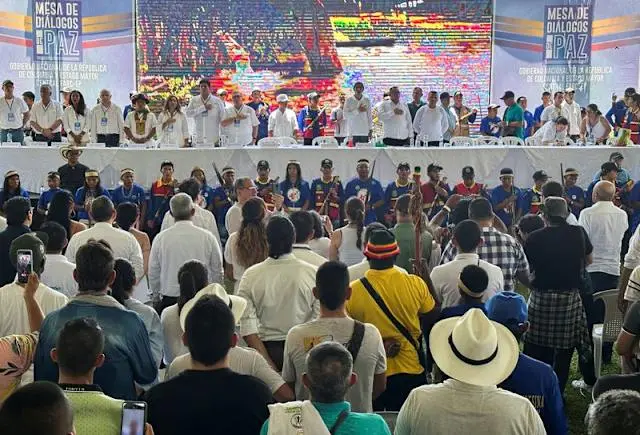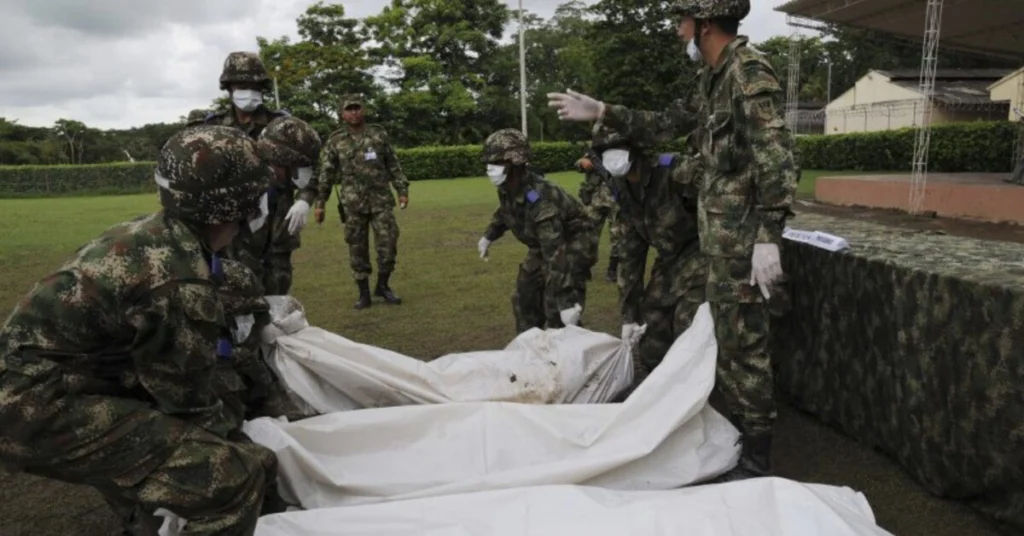Critical 13.5 Tons of Weapons: Colombia FARC Dissident Disarmament Marks Key Step Toward Total Peace

Colombia FARC dissident disarmament begins. 20/7/2025
July 20, 2025 Hour: 2:22 pm
Colombia FARC dissident disarmament advances as 13.5 tons of war material are set for destruction. Government and CNEB agree to peace steps under Petro’s “Total Peace” policy.
Related: Colombia’s Historic Pact Sets October Primary Ahead of 2026 Presidential Race
Geopolitical Context Behind the Colombia FARC Dissident Disarmament
The Colombia FARC dissident disarmament marks a major development in the country’s long and complex peace process. On July 20, 2025, the Colombian government and the National Coordinator Bolivarian Army (CNEB) — a faction that broke away from the Second Marquetalia, a FARC dissident group — agreed to the surrender and destruction of 13.5 tons of war material.
This agreement, reached during the fifth round of peace talks in the Inda Zabaleta Indigenous Territory in Tumaco, Nariño, represents a strategic step toward consolidating peace in regions historically plagued by violence, drug trafficking, and armed conflict.
Colombia FARC Dissident Disarmament: 13.5 Tons of Weapons to Be Destroyed
In a historic move, the Colombia FARC dissident disarmament agreement will see the National Coordinator Bolivarian Army (CNEB) hand over approximately 13.5 tons of war material for destruction. The weapons are currently stored in Nariño and Putumayo, two southern departments that have long been hotspots for armed conflict and illegal activity.
The agreement was reached after five negotiation cycles held in Tumaco, Nariño, and is part of President Gustavo Petro’s broader “Total Peace” initiative, which seeks to bring all armed groups into peace talks and disarmament processes.
“This is a contribution to building trust between the parties and breaking the cycle of violence,” said Armando Novoa, head of the government delegation.
🔗 EFE News – FARC Dissident Report
Disarmament Protocol: Five Stages Under International Oversight
The disarmament process is structured in five technical and verifiable stages:
- Operational activation
- Delivery and verification
- Technical custody and transfer
- Destruction
- Final evaluation
Each phase will be documented through technical agreements signed by both parties and international observers. The OAS Mission to Support the Peace Process in Colombia (MAPP-OEA) will supervise the operation, ensuring transparency and security.
The Colombian public force and the National Peace Commissioner’s Office will also play a role in overseeing the process, reinforcing the government’s commitment to peace and disarmament.

CNEB and Government Commit to Mutual Security Guarantees
As part of the agreement, the CNEB has pledged to halt all offensive actions and ensure that its members are disarmed and properly identified during the surrender process. This includes refraining from any interference in the disarmament procedures.
In return, the government has guaranteed physical and legal protection to the CNEB delegation, a crucial step in building trust and ensuring the safety of former combatants who choose to lay down their weapons.
This mutual commitment is seen as a breakthrough in Colombia’s peace efforts, as it sets a precedent for other armed groups still operating in the region.
Peace Process and Territorial Transformations
The agreement is part of a broader peace framework that includes discussions on territorial reforms, community security, legal guarantees for former combatants, political participation, and social inclusion.
Earlier stages of the dialogue had already seen the CNEB commit to non-interference in local elections, facilitating voter registration, and allowing displaced communities to return safely.
These steps are essential to rebuilding trust in regions long dominated by violence, and align with the government’s “Total Peace” policy, which seeks to include all armed actors in the path to peace.
Regional and International Significance of Colombia’s Disarmament
The Colombia FARC dissident disarmament is being closely watched by regional and international observers, as it could serve as a model for similar negotiations with other armed groups in Latin America.
The OAS Mission to Support the Peace Process in Colombia (MAPP-OEA) has played a key role in ensuring the process remains transparent and verifiable. International observers believe the agreement could inspire future peace efforts in areas affected by long-standing armed conflict.
“This is a clear signal that dialogue can prevail over violence,” said a peace analyst. “Colombia is proving that even post-conflict transitions can be managed with the right political will and oversight.”
Conclusion: A Step Toward Lasting Peace
The Colombia FARC dissident disarmament agreement is a milestone in the country’s pursuit of peace, especially in Nariño and Putumayo, where decades of conflict have left communities displaced, impoverished, and vulnerable.
President Gustavo Petro is expected to attend the formal commemoration of the agreement, reinforcing his administration’s commitment to ending violence through dialogue and reconciliation.
While challenges remain — including the presence of other armed groups and ongoing drug trafficking — this agreement shows that peace is possible when political will and international support align.
Author: JMVR
Source: Gobierno de Colombia - Agencias

